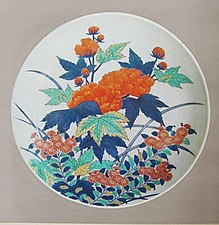

Overglaze decoration, overglaze enamelling, or on-glaze decoration, is a method of decorating pottery, most often porcelain, where the coloured decoration is applied on top of the already fired and glazed surface, and then fixed in a second firing at a relatively low temperature, often in a muffle kiln. It is often described as producing "enamelled" decoration. The colours fuse on to the glaze, so the decoration becomes durable. This decorative firing is usually done at a lower temperature which allows for a more varied and vivid palette of colours, using pigments which will not colour correctly at the high temperature necessary to fire the porcelain body. Historically, a relatively narrow range of colours could be achieved with underglaze decoration, where the coloured pattern is applied before glazing, notably the cobalt blue of blue and white porcelain.
Many historical styles, for example mina'i ware, Imari ware, Chinese doucai, and wucai, combine the two types of decoration.[1] In such cases the first firing for the body, underglaze decoration and glaze is followed by the second firing after the overglaze enamels have been applied.
The technique essentially uses powdered glass mixed with coloured pigments, and is the application of vitreous enamel to pottery; enamelled glass is very similar but on glass. Both these latter two are essentially painting techniques, and have been since they began. In contrast, on metal painting in enamel arrived very late, long after techniques such as cloisonné, where thin wires are applied to form raised barriers, which contain areas of (subsequently applied) enamel, and champlevé, where the metal surface is sunk to form areas where the enamel is poured.
In Chinese porcelain, enamels were and are sometimes applied to unglazed pieces; this is called "enamel on the biscuit" and similar terms.
- ^ Vainker, 188–189, 192–193, 195
